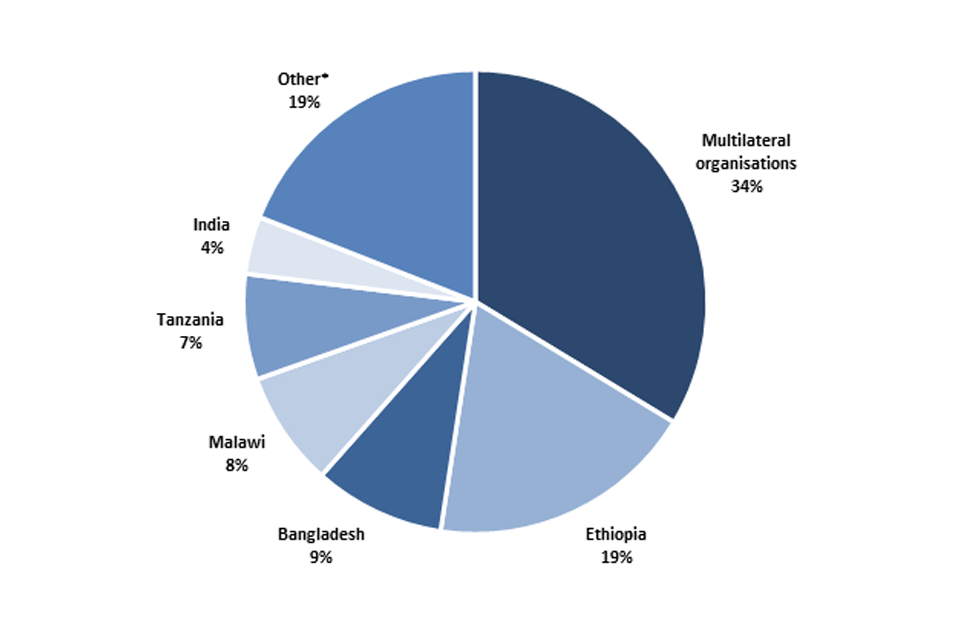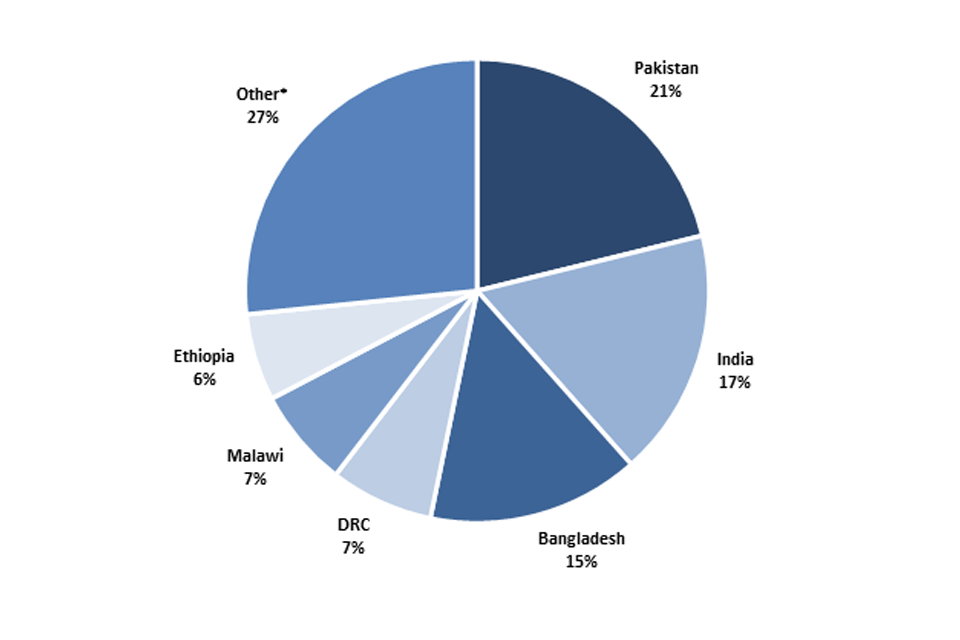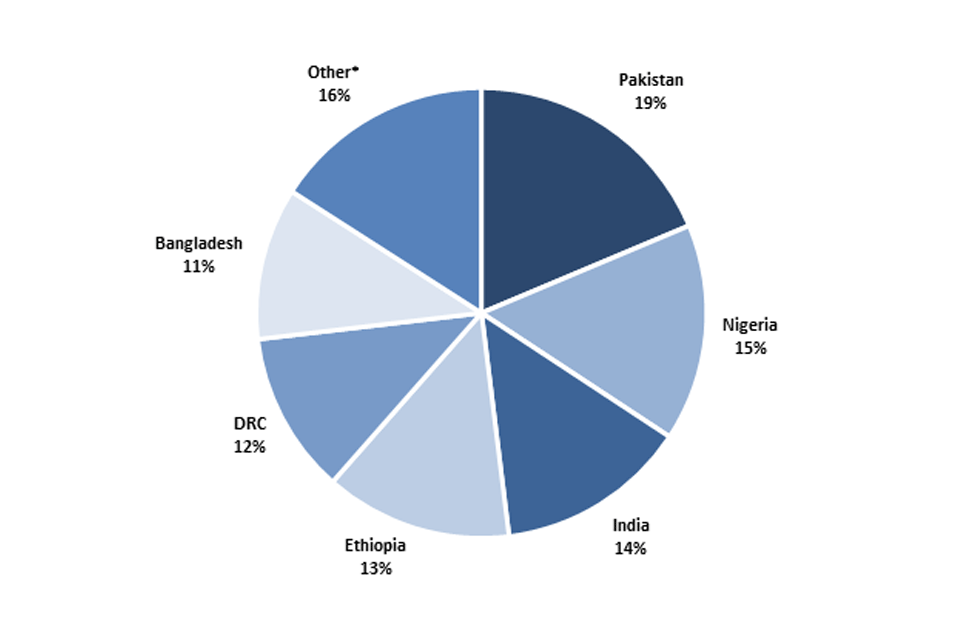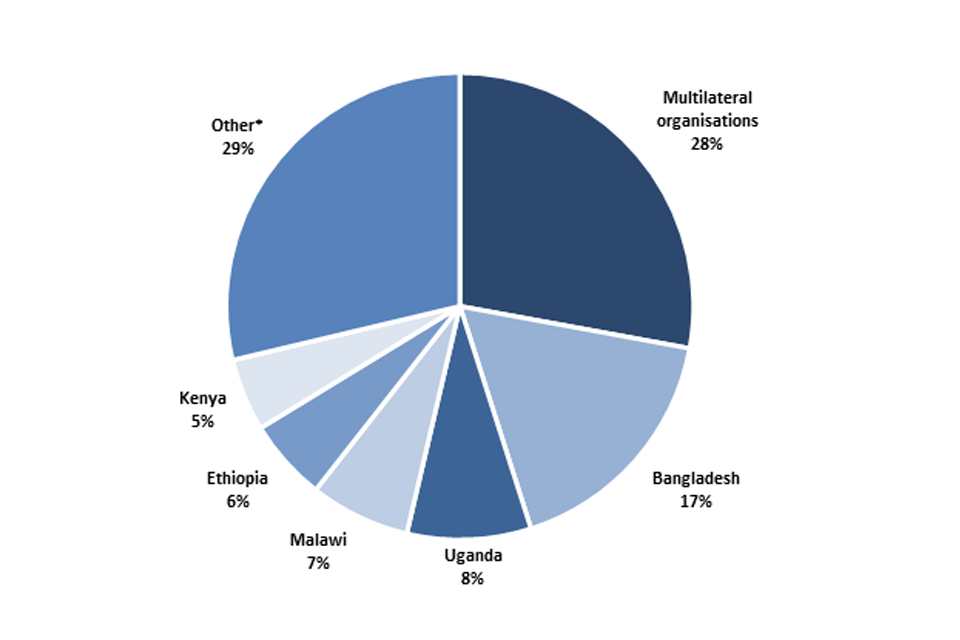DFID Annual Report and Accounts 2014-15 Results achieved by sector: Health
Published 16 July 2015
Poor health is both a cause and a consequence of poverty, and widens inequalities. Globally, health is improving. Yet the poorest people in both low and middle income countries suffer the most from ill health, and women suffer more than men[footnote 1].
Progress has been made against the three MDGs which relate to health: MDG 4 (reduce child mortality), MDG 5 (improve maternal health) and MDG 6 (combat HIV/AIDS, malaria and other diseases). However, improvements are insufficient to achieve all the targets by 2015. Between 1990 and 2013, the under-5 mortality rate declined by 49%; with a reduction in the number of deaths from 12.7 million to 6.3 million[footnote 2]. Over the same period, the maternal mortality ratio declined by 45%, from 380 to 210 deaths per 100,000 live births between 1990 and 2013[footnote 3]. Globally, between 2000 and 2013, the malaria mortality rate declined by 47%; and malaria incidence per 1,000 population at risk (which takes account of population growth over time) declined by 30%[footnote 4].
Most maternal mortality is preventable by ensuring women have access to modern contraceptives and by appropriate care and the availability of lifesaving medicines and equipment during pregnancy and childbirth. Of the 125 million women who give birth each year, 54 million have fewer than four antenatal visits and 21 million do not receive care for major obstetric complications[footnote 5].
Sexual and reproductive health services fall short of global needs. In 2014, 225 million women who wished to avoid pregnancy were not using an effective method of contraception[footnote 6].
DFID works in partner countries to strengthen health systems, train health professionals, and improve the availability of essential commodities including vaccines, medicines and contraceptives.
1. DFID commitment
DFID has committed to:
- save the lives of 50,000 women in pregnancy and childbirth (by December 2015)
- save the lives of 250,000 newborn babies (by December 2015)
- help halve the number of deaths from malaria in at least 10 high burden countries (by March 2015)
- support 2 million births with skilled birth attendants (by March 2015)
- enable an additional 10 million couples to access modern methods of family planning, including 1 million young women aged 15-19 years (by March 2015)
- help immunise more than 55 million children against preventable diseases (by March 2015)
2. Indicators used to measure progress
- number of maternal lives saved through DFID support (modelled)
- number of newborn lives saved through DFID support (modelled)
- number of malaria deaths per 100,000 persons per year (modelled)
- number of insecticide treated bed-nets distributed with DFID support
- number of births delivered with the help of nurses, midwives or doctors through DFID support
- number of additional women using modern methods of family planning through DFID support
- number of children immunised against preventable disease through support to GAVI
3. Results achieved
By 2014-15, DFID had achieved the following results:
- 44,000 maternal lives saved (based on results to end 2013 only)
- 97,000 newborn lives saved (based on results to end 2013 only)
- contribution to a reduction in malaria mortality from 33 malaria attributable deaths per 100,000 at risk worldwide in 2009 to 26 malaria attributable deaths per 100,000 at risk worldwide in 2013 (a 21% reduction).
- 47.4 million long-lasting insecticide-treated bednets distributed
- 5.1 million births attended by a skilled birth attendant
- 9.3 million additional women using modern methods of family planning
- 43.8 million children immunised against preventable diseases (based on results to end 2013 only)
Between 2011 and 2013, DFID saved 44,000 maternal lives and 97,000 newborn lives. These results cannot be measured directly; they are modelled from programmes on reproductive, maternal and newborn health; HIV; malaria; other health; water, sanitation and hygiene (WASH); nutrition; humanitarian assistance; and general and health sector budget support. Maternal lives saved come from bilateral, multilateral and regional sources. Newborn lives saved come from bilateral programmes. There is a time lag of over a year in reporting results on these modelled indicators. The outcome of increased programming in 2014 and 2015 to accelerate progress towards targets will be reported in 2016 and 2017.
Since 2010, DFID has enabled 9.3 million additional women to use modern methods of family planning. This figure includes 2.9 million women living in the poorest 40% of households, and 960,000 women aged 15–19 years. About half of these results come from bilateral programmes, a third from multilateral contributions to the United Nations Population Fund’s (UNFPA) global programme to enhance reproductive health commodity security (GPRHCS). Smaller contributions have come from regional and civil society programmes.
Since 2010, DFID has enabled 5.1 million births to be attended by a skilled birth attendant. Almost all these results come from bilateral programmes, with a small contribution through civil society programmes.
DFID remains a leading donor supporting the global HIV response. As DFID graduates funding from bilateral partnerships with middle-income countries, it has increasingly worked through global and regional mechanisms, such as UNAIDS and the Global Fund for AIDS, TB and Malaria; and civil society. DFID focuses on key vulnerable populations, and continues to support comprehensive evidence-based prevention, including harm reduction for injecting drug users, and addressing structural barriers, including stigma, discrimination and gender inequality.
DFID’s bilateral and multilateral malaria investments contributed to a further reduction in malaria attributable deaths. In 2013, there were an estimated 198 million cases and 584,000 deaths. The World Health Organisation (WHO) estimate that in 2013, there were 26 malaria attributable deaths per 100,000 at risk worldwide, down from 33 in 2009 (a 21% reduction). The bulk of these deaths occurred in Africa. In Africa there were an estimated 75 malaria attributable deaths per 100,000 at risk in 2013 down from 98 in 2009 (a 23% reduction). As with maternal and newborn health, there is a time lag in reporting results and the outcome of programming in 2014 and 2015 to accelerate progress towards targets will be reported in 2016 and 2017.
Since 2010, DFID has distributed 47.4 million long-lasting insecticide-treated bednets through its bilateral support. This contributed to successfully increasing the number of people at risk of malaria sleeping under an insecticide-treated bednet to 44% in 2013, compared to just 2% in 2004. Through support to GAVI, 43.8 million children have been immunised against preventable diseases.
4. Progress towards DFID results commitments
Results achieved up to 2014-15 inclusive
| Indicator | Indicator type | Results Commitment | Male | Female | Not identified | Total |
|---|---|---|---|---|---|---|
| Number of maternal lives saved through DFID support* | Modelled | 50,000 | N/A | 44,000 | N/A | 44,000 |
| Number of newborn lives saved through DFID support | Modelled | 250,000 | 0 | 0 | 97,000 | 97,000 |
| Number of malaria deaths (per 100,000 persons per year) | Modelled | Halve deaths in 10 countries | 0 | 0 | 26 (worldwide) | 26 (worldwide) |
| Number of insecticide treated bed-nets distributed with DFID support | Cumulative | No specific target | N/A | N/A | N/A | 47,400,000 |
| Number of births delivered with the help of nurses, midwives or doctors through DFID support | Cumulative | 2,000,000 | N/A | N/A | N/A | 5,110,000 |
| Number of additional women using modern methods of family planning through DFID support* | Cumulative | 10,000,000 | N/A | 9,330,000 | N/A | 9,330,000 |
| Number of children immunised against preventable disease through support to GAVI** | Cumulative | 55,000,000 | 0 | 0 | 43,820,000 | 43,820,000 |
*Results delivered through both multilateral and bilateral channels
**Results delivered through multilateral channels only
5. Results achieved by country/department
DFID operates reproductive, maternal and newborn health programmes in 20 countries. The greatest numbers of additional family planning users have been achieved in Bangladesh, Uganda, Malawi, Ethiopia and Kenya. The greatest numbers of births attended by nurses, midwives or doctors have been achieved in Pakistan, Nigeria, India, Ethiopia and DRC.
DFID operates malaria programmes in 14 countries. Countries distributing the most bednets are Kenya, DRC, Nigeria, Ghana and Uganda.
5.1 Number of maternal lives saved through DFID support (by country/department)

Number of maternal lives saved through DFID support (by country/department)
5.2 Number of newborn lives saved through DFID support (by country/department)

Number of newborn lives saved through DFID support (by country/department)
5.3 Number of insecticide treated bed-nets distributed with DFID support (by country/department)

Number of insecticide treated bed-nets distributed with DFID support (by country/department)
5.4 Number of births delivered with the help of nurses, midwives or doctors through DFID support (by country/department)

Number of births delivered with the help of nurses, midwives or doctors through DFID support (by country/department)
5.5 Number of additional women using modern methods of family planning through DFID support (by country/department)

Number of additional women using modern methods of family planning through DFID support (by country/department)
6. Results achieved by multilateral organisations
The following results are delivered by multilateral organisations, and fall broadly within the health sector. These indicators were included in the multilateral section of DFID’s Results Framework. The results presented here are based on all funding that the multilateral receives, not just funding from DFID or the UK. These results are presented alongside DFID’s share of core funding to the multilateral organisations, in order to illustrate that DFID contributes a share of those results. Multilateral abbreviations and results sources can be found in the results technical notes.
| Indicator | Multilateral | Latest Results | Reporting period | DFID’s contribution as a % of total core funding[footnote 8] |
|---|---|---|---|---|
| Number of children immunised against preventable disease | GAVI | 53,000,000 | 2013 | 30 |
| Number of HIV positive women provided with treatment to prevent transmission to their babies | GFATM[footnote 9] | 320,000 | 2014 | 11 |
| Number of insecticide treated bednets distributed | GFATM[footnote 9] | 87,000,000 | 2014 | 11 |
| Additional number of people provided with treatment for AIDS | GFATM[footnote 9] | 1,200,00 | 2014 | 11 |
| Number of tuberculosis cases detected and treated | GFATM[footnote 9] | 1,100,000 | 2014 | 11 |
| Number of children immunised | IDA | 138,400,000 | FY 2013-14 | 11 |
| Number of people who have received essential health, nutrition and population (HNP) services | IDA | 376,400,000 | FY 2013-14 | 11 |
| Number of female condoms procured | UNFPA | 18,846,000 | 2013 | 7 |
| Number of vitamin A treatments procured | UNICEF | 529,244,000 | 2014 | 6 |
| Number of children on HIV/ AIDS medicines | UNITAID | 44,000 | 2013 | 31 |
| Number of children supplied with child-friendly TB treatments | UNITAID | 62,000 | 2013 | 31 |
-
DFID (July 2013) Health Position Paper, Delivering Health Results. ↩
-
United Nations Interagency Group for Child Mortality Estimation (IGME) (September 2014), Levels and Trends in Child Mortality–Report 2014. Available from: www.childmortality.org/files_v17/download/UNICEF%202014%20IGME%20child%20mortality%20Report_Final.pdf . ↩
-
United Nations (July 2014), The millennium development goals report 2014. ↩
-
World Health Organization (December 2014), World Malaria Report 2014. ↩
-
Guttmacher Institute (December 2014), Adding It Up: The costs and benefits of investing in sexual and reproductive health 2014. ↩
-
Guttmacher Institute (December 2014), Adding It Up: The costs and benefits of investing in sexual and reproductive health 2014. ↩
-
The DFID burden share presented here are not suitable to calculate a DFID results attribution of multilateral results. The results presented in this table are achieved through all funding streams that the multilateral receive, not just limited to core funding. ↩
-
GFATM does not engage in direct procurement activities; instead these are managed under the full responsibility of grant recipients. However, GFATM provides mechanisms to promote and cost-effective procurement of health products. ↩ ↩2 ↩3 ↩4
